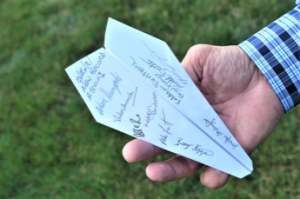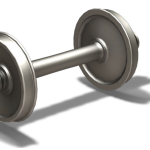Practitioner Course Preps Employees to Drive Continuous Improvement
Stucki recently rolled out a continuous improvement practitioner course to train employees on continuous improvement concepts through lecture, discussion and interactive simulation.
Twelve students from various Stucki locations, who were selected by their general managers, attended the 3 1/2-day course at Seco Machine in North Canton in August to gain the knowledge and hands-on experience they need to drive small improvements across the company.
“People are the only resource we have at Stucki capable of infinite appreciation in value,” said MIKE WALL, senior vice president at Stone Canyon Holdings, Stucki’s parent company.
“We must make the investment of their time and ours to realize this return. This CIP course was one of the first steps in that process.”
The course included an interactive simulation focused on building and flying paper airplanes. Participants applied the knowledge gained throughout the course to complete the simulation in record time (see accompanying story).
 Students leave the course with a working knowledge of the five lean thinking principles, the difference between “value-added” and “non-value-added” activities, the seven wastes present in every process, the eighth and worst waste, waste identification tools, foundational continuous improvement tools, the plan-do-check-adjust cycle, the seven-step problem solving process and A3 reports, the five phases of team development, team facilitation skills and conducting a rapid improvement event.
Students leave the course with a working knowledge of the five lean thinking principles, the difference between “value-added” and “non-value-added” activities, the seven wastes present in every process, the eighth and worst waste, waste identification tools, foundational continuous improvement tools, the plan-do-check-adjust cycle, the seven-step problem solving process and A3 reports, the five phases of team development, team facilitation skills and conducting a rapid improvement event.
Each participant received a certification of completion after the course and is expected to continue their development by completing the continuous improvement qualification process in about two years.
“After completing the course, students are expected to demonstrate the ability to lead teams through a number of continuous improvement processes described on the qualification card,” said Mike. “They also have to complete their assigned readings.”
Each candidate is expected to facilitate four to six continuous improvement team activities or projects per year.
“The continuous improvement efforts will help us make all of our processes safer and easier for our employees to perform, with better quality and faster service for our customers, and at a lower cost,” said Mike.
“This will help Stucki achieve its objectives of being the best in the industry and increasing profitability.”
<w/ stack of paper airplanes>
Paper Airplane Exercise Helps Skills Take Flight
A simulation requiring students to rapidly build paper airplanes is helping to launch the expansion of Stucki’s continuous improvement capabilities.
As part of the training, students are asked to produce one airplane in 60 seconds, six airplanes in 120 seconds and 25 airplanes in 300 seconds with no defects and earn a profit using continuous improvement tools and concepts, explains MIKE WALL, senior vice president at Stone Canyon Holdings, Stucki’s parent company.
“The production of the airplane is considered a success if it is built and flies successfully, 15 feet, far and straight, within the time limits,” he said.
Each successful plane earns the team revenue and each defective plane, piece of inventory and second of labor is subtracted from the revenue. One particular group of students recently broke the Stucki record for highest profit earned.
“I’ve taught the course more than 200 times at dozens of companies over the past 20 years and always kept track of the course,” said Mike. “If a class gets close to the record by round five of the simulation, I let them go another round to attempt to break the record.”
“After coming close in round six, candidates stayed late after the course and broke the record in round seven. They met the delivery requirements, notched the highest profit, least amount of defects and best productivity.”
The simulation training prepares students to begin facilitating continuous improvement activities at their home locations.





